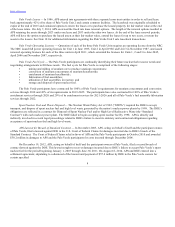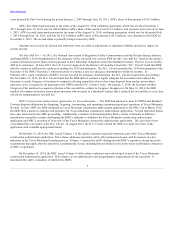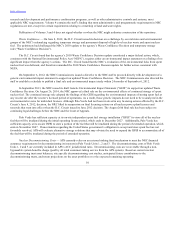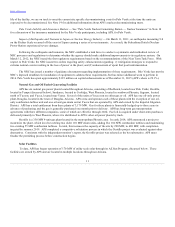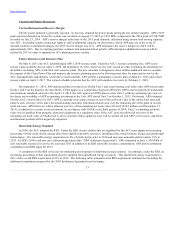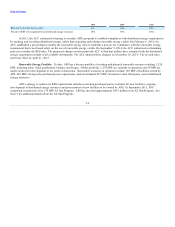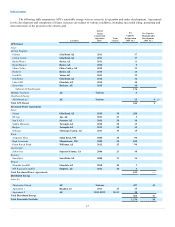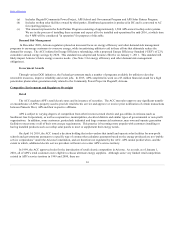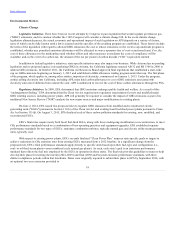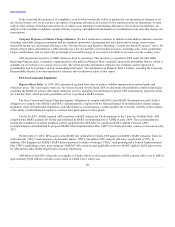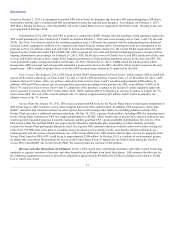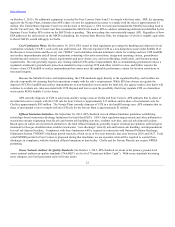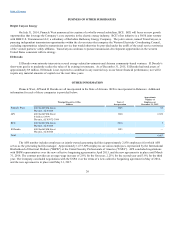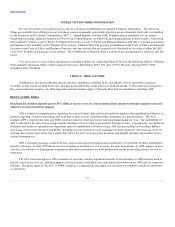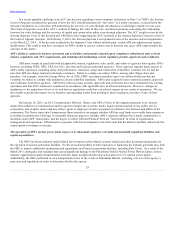APS 2015 Annual Report Download - page 21
Download and view the complete annual report
Please find page 21 of the 2015 APS annual report below. You can navigate through the pages in the report by either clicking on the pages listed below, or by using the keyword search tool below to find specific information within the annual report.
Table of Contents
Environmental Matters
Climate Change
Legislative Initiatives. There have been no recent attempts by Congress to pass legislation that would regulate greenhouse gas
("GHG") emissions, and it is unclear whether the 114th Congress will consider a climate change bill. In the event climate change
legislation ultimately passes, the actual economic and operational impact of such legislation on APS depends on a variety of factors,
none of which can be fully known until a law is enacted and the specifics of the resulting program are established. These factors include
the terms of the legislation with regard to allowed GHG emissions; the cost to reduce emissions; in the event a cap-and-trade program is
established, whether any permitted emissions allowances will be allocated to source operators free of cost or auctioned (and, if so, the
cost of those allowances in the marketplace) and whether offsets and other measures to moderate the costs of compliance will be
available; and, in the event of a carbon tax, the amount of the tax per pound of carbon dioxide (“CO2”) equivalent emitted.
In addition to federal legislative initiatives, state-specific initiatives may also impact our business. While Arizona has no pending
legislation and no proposed agency rule regulating GHGs in Arizona, the California legislature enacted AB 32 and SB 1368 in 2006 to
address GHG emissions. In October 2011, the California Air Resources Board approved final regulations that established a state-wide
cap on GHG emissions beginning on January 1, 2013 and established a GHG allowance trading program under that cap. The first phase
of the program, which applies to, among other entities, importers of electricity, commenced on January 1, 2013. Under the program,
entities selling electricity into California, including APS, must hold carbon allowances to cover GHG emissions associated with
electricity sales into California from outside the state. APS is authorized to recover the cost of these carbon allowances through the PSA.
Regulatory Initiatives. In 2009, EPA determined that GHG emissions endanger public health and welfare. As a result of this
“endangerment finding,” EPA determined that the Clean Air Act required new regulatory requirements for new and modified major
GHG emitting sources, including power plants. APS will generally be required to consider the impact of GHG emissions as part of its
traditional New Source Review ("NSR") analysis for new major sources and major modifications to existing plants.
On June 2, 2014, EPA issued two proposed rules to regulate GHG emissions from modified and reconstructed electric
generating units ("EGUs") pursuant to Section 111(b) of the Clean Air Act and existing fossil fuel-fired power plants pursuant to Clean
Air Act Section 111(d). On August 3, 2015, EPA finalized each of these carbon pollution standards for existing, new, modified, and
reconstructed EGUs.
EPA’s final rules require newly built fossil fuel-fired EGUs, along with those undergoing modification or reconstruction, to meet
CO2 performance standards based on a combination of best operating practices and equipment upgrades. EPA established separate
performance standards for two types of EGUs: stationary combustion turbines, typically natural gas; and electric utility steam generating
units, typically coal.
With respect to existing power plants, EPA’s recently finalized “Clean Power Plan” imposes state-specific goals or targets to
achieve reductions in CO2 emission rates from existing EGUs measured from a 2012 baseline. In a significant change from the
proposed rule, EPA’s final performance standards apply directly to specific units based upon their fuel-type and configuration (i.e.,
coal- or oil-fired steam plants versus combined cycle natural gas plants). As such, each state’s goal is an emissions performance
standard that reflects the fuel mix employed by the EGUs in operation in those states. The final rule provides guidelines to states to help
develop their plans for meeting the interim (2022-2029) and final (2030 and beyond) emission performance standards, with three
distinct compliance periods within that timeframe. States were originally required to submit their plans to EPA by September 2016, with
an optional two-year extension provided to
18


